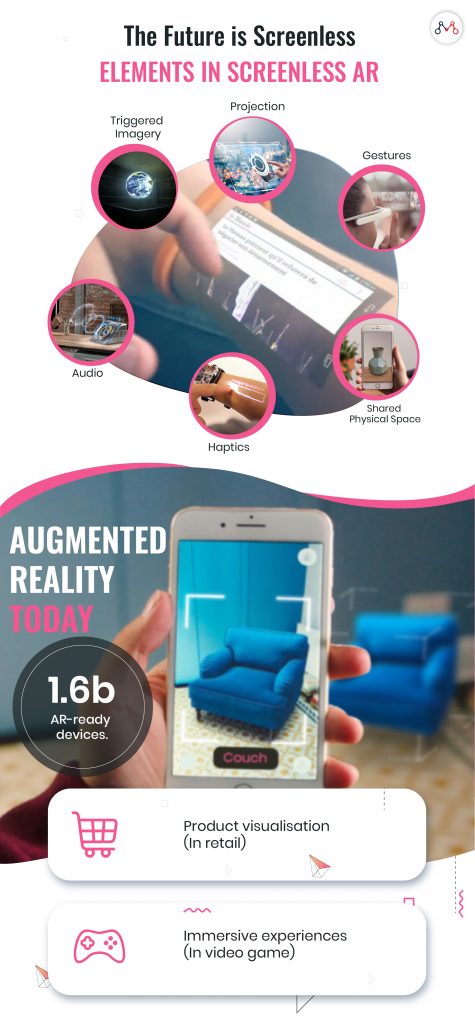Screenless technology uses augmented reality to superimpose interactable imageries on users’ surroundings. AR is redefining the future of experiences. This article brings forth applications of augmented reality in designing screenless interfaces. It also discusses the psychological impact of augmenting computer-generated visuals in the real world.
Applications of Augmented Reality in Screenless Technology
According to MarketsandMarkets research, the screenless display market is projected to reach $5.7 billion by 2020. In a near-future, augmented reality would be able to project imagery onto almost any surface and medium. However, there’s another aspect of screenless interfaces accompanied by audio and haptics.

AR Audio
Imagine you come across a billboard with a picture of diamond jewellery. You’re impressed and want to know more about the ad. Typically, you’ll pick your phone, type some search queries and then get to know the information about the product. What if you can skip the process and get the information instantly?
AR Audio gives audio responses according to the user’s visual cues. It fulfils the user’s need for information on demand immediately. The technology is advancing to an extent that the AR device can measure your gaze direction and locate the objects in your range of vision!
Sturfee’s Visual Positioning Service (VPS) is a remarkable attempt towards AR innovations.
Seamless Projection
The recent development in augmented reality eliminates the need for bulky headsets or special glasses to see an augmented view of the world. In fact, the screenless display market is projected to reach $5.7 Bn by 2020.
This is possible by seamlessly projecting the imagery in a shared physical space. That is, mapping the imagery on a street or a playground, where many people can simultaneously witness the virtual aspects of augmented reality. The ability to project visuals seamlessly on any surface is one of the biggest applications of augmented reality feasible today.
Humane Creatures
The next take on coupling augmented reality with artificial intelligence is the development of humane creatures or avatars. These human-like intelligent beings can act as a learning companion for children suffering from autism. Augmented reality can smartly interact with children, ask questions, encourage, offer suggestions, and can be a companion in their tough time.
In her book – The Art of Screen Time, Anya Kamenetz mentions Alex, a research project directed by Cassell’s PhD student Samantha Finkelstein. Alex is a gender-ambiguous 8-year-old intelligent augmented reality avatar. During an experiment in a classroom at a charter school in Pittsburgh, students along with Alex discuss their know-how about a picture of a dinosaur. Alex couldn’t catch everything that other students were saying and sometimes his responses are inappropriate. But, this illusion of conversation is a step forward towards the new developments in the AR arena.
Screenless Time?
‘Modifying reality’ is putting a question mark on the psychological impact of augmented reality. Augmented reality together with artificial intelligence is creating environments next to real. Are our mental-models ready to adapt? Or a sudden disruption is going to play with our sentiments? Unfortunately, there are no concrete answers to these questions.
Today, kids (aged between 8 & 18) spend on average more than 7 hours every day looking at screens. However, the new AHA guideline recommends screen time to be at a maximum of two hours per day. In the not so distant future, kids will be growing up with AR accompanying them throughout their day. Whether they are learning about something new or shopping online, AR will have merged and formed a virtual tether with their daily routines.
While screenless AR does pose several questions around its ethical benefits — with responsible use we can harness the best from this technology.
Augmented Reality Best Practices
- While using Augmented Reality in design, keep in mind the users’ real-world context. Do not distract or mislead them for social, political, or economic benefits.
- Do not play with emotions or drown user senses into meaningless things.
- Augmented Reality is data-rich. Ensure the safety of users’ data.
Concluding Remarks
Haptics, gesture control, Synaptics, and triggered imagery are adding intractability to the screenless technology. Today, video games and retail are harnessing augmented reality the most. The future awaits more applications of augmented reality to build screenless interfaces across different industries.
Knowledge thats worth delivered in your inbox




